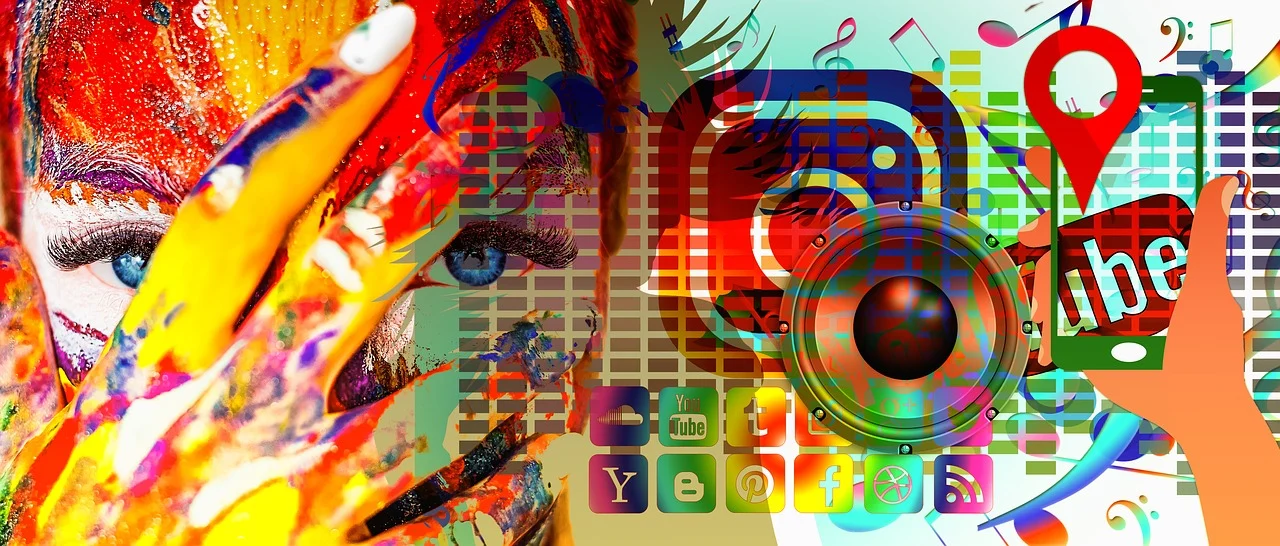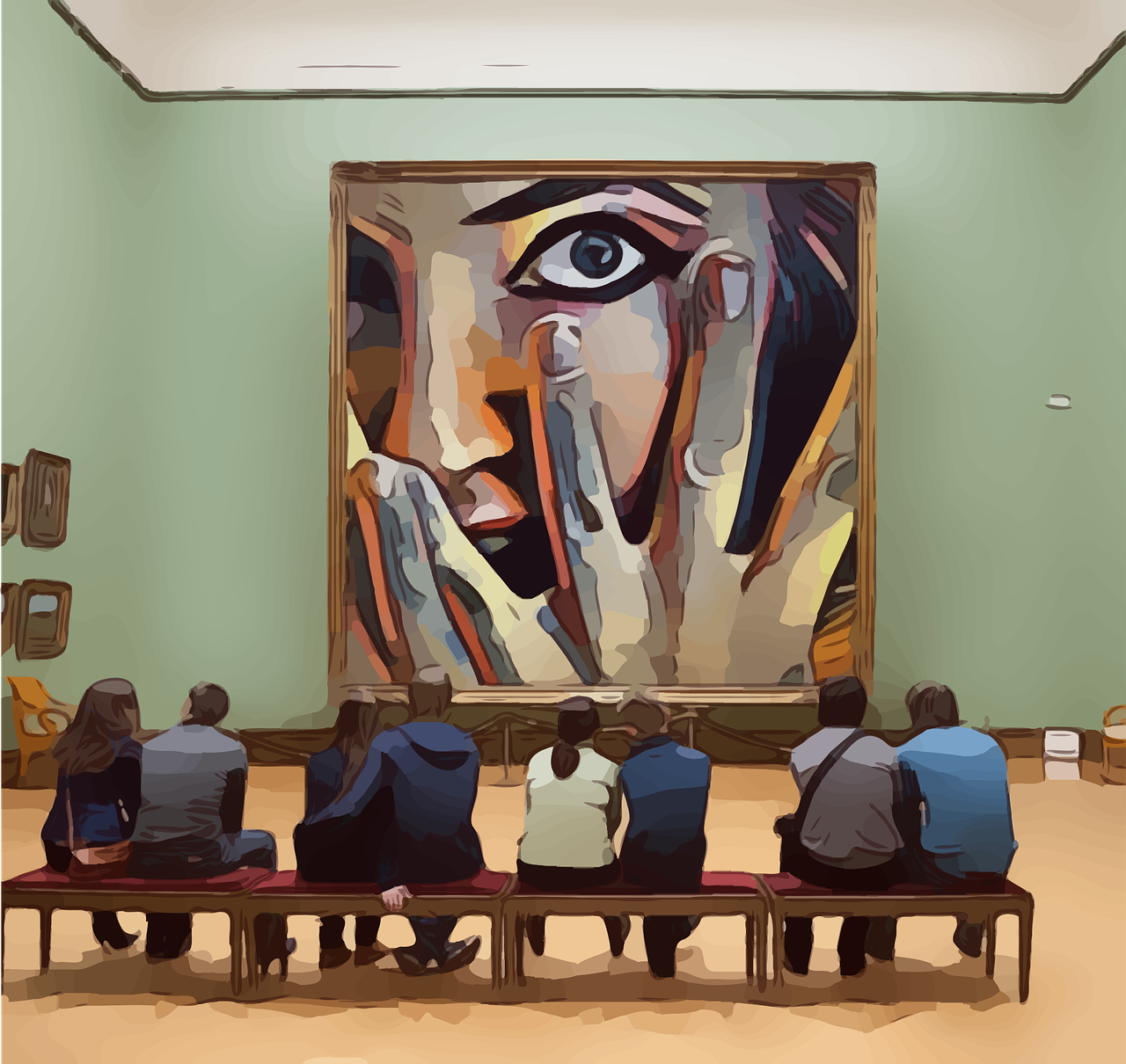In today’s digital landscape, social media has become an indispensable tool for promoting contemporary art. Both artists and galleries can leverage these platforms to reach a broader audience, engage with potential buyers, and build a strong online brand. This comprehensive guide will explore in-depth strategies and actionable tips to effectively promote contemporary art on social media, including how to leverage AI tools for content creation and optimization.

Understanding Your Target Audience
Identifying Potential Buyers and Followers
Understanding who your potential buyers and followers are is crucial for effective social media promotion. This includes identifying art enthusiasts, collectors, critics, curators, and even interior designers or corporate art consultants.
To gain insights into your audience demographics, consider using these tools:
- Instagram Insights: Provides data on follower demographics, location, and engagement.
- Facebook Audience Insights: Offers detailed information about your page followers and the broader Facebook audience.
- Twitter Analytics: Shows follower growth, tweet impressions, and audience interests.
- Google Analytics: If you have a website, this tool can provide valuable data on your visitors’ demographics and behavior.
Audience Demographics and Content Preferences
| Age Group | Location | Art Preferences | Preferred Social Media Platforms | Content Type Preferences |
| 18-25 | Urban | Street art, Digital art | Instagram, TikTok, Snapchat | Short-form videos, AR filters |
| 26-35 | Suburban | Mixed media, Contemporary | Instagram, Facebook, Pinterest | Behind-the-scenes content, Process videos |
| 36-50 | Global | Abstract, Minimalist | Facebook, Twitter, LinkedIn | In-depth articles, Virtual gallery tours |
| 51+ | Rural | Traditional, Impressionist | Facebook, LinkedIn, YouTube | Artist interviews, Historical context videos |
Understanding Audience Engagement

Knowing how your audience engages with content is key to creating an effective social media strategy. Analyze which types of posts (images, videos, stories) get the most engagement. Here are some engagement strategies to implement:
- Ask open-ended questions in your captions to encourage comments.
- Create polls in Instagram Stories or Twitter to gather opinions on art-related topics.
- Use interactive features like Instagram’s “Add Yours” sticker to encourage user participation.
- Host live Q&A sessions or virtual studio tours to connect directly with your audience.
- Implement a consistent hashtag strategy to increase discoverability.
Tools like Hootsuite, Buffer, or Sprout Social can help track engagement metrics and identify trends. These platforms offer features such as:
- Scheduling posts across multiple platforms
- Analyzing post performance
- Monitoring mentions and comments
- Generating comprehensive reports
Crafting Compelling Visual Content
High-Quality Images and Videos
High-quality visuals are essential for grabbing attention on social media. When photographing or filming artwork, consider the following tips:
- Lighting: Use natural light when possible, or invest in a good lighting setup. Avoid harsh shadows or glare.
- Background: Choose a clean, neutral background that doesn’t distract from the artwork.
- Angles: Capture multiple angles to showcase different aspects of the piece.
- Scale: Include objects for scale if the size of the artwork is important.
- Details: Provide close-up shots to highlight textures and intricate details.
Tools for enhancing your photos and videos:
- Adobe Lightroom: Professional-grade photo editing software
- Snapseed: A powerful, free mobile editing app
- VSCO: Offers high-quality filters and editing tools
- Canva: User-friendly graphic design tool with photo editing capabilities
- iMovie or Adobe Premiere Rush: For creating and editing videos
Best Practices for Visual Content Creation
| Content Type | Tools | Tips | Common Mistakes | Advanced Techniques |
| Photographs | DSLR or smartphone, Lightroom | Use natural light, clean background | Poor focus, distracting props | Focus stacking for sharp images, HDR for high contrast scenes |
| Videos | Smartphone, iMovie, FiLMiC Pro | Keep it short (15-60 seconds), use captions | Shaky footage, poor audio | Use a gimbal for smooth motion, external microphone for clear audio |
| Instagram Stories | Canva, Over, Unfold | Use templates, add interactive elements | Overusing text, cluttered design | Create a cohesive visual style, use brand colors consistently |
| Reels | InShot, CapCut, Adobe Premiere Rush | Follow trends, use popular music | Too long, not showcasing art | Incorporate transitions, use text overlays for context |
| Time-lapse | GoPro, Hyperlapse app | Show the creative process | Inconsistent lighting, camera movement | Use interval shooting for long processes, stabilize in post-production |
Telling a Story Through Visuals
Use visuals to tell compelling stories about your artwork, creative process, or inspiration. Here are some ideas:
- Create a series of posts that explore the development of a single piece of art.
- Share behind-the-scenes content of your studio or gallery preparation.
- Produce artist interviews or curator talks as video content.
- Develop a visual narrative around the inspiration for a collection.
- Use before-and-after images to showcase restoration or installation processes.
Example storyline for a series of posts:
- Inspiration: Share the initial sketch or concept
- Process: Show various stages of creation
- Challenges: Discuss obstacles overcome during creation
- Completion: Reveal the finished piece
- Context: Display the artwork in situ or as part of a collection
Leveraging AI Tools for Social Media Content

AI-Powered Content Generation
AI tools can help artists and galleries save time and maintain consistency in their posting schedules. These tools can generate captions, hashtags, and even visual elements like artwork previews or mockups.
Comparison of AI Content Generation Tools
| Tool | Features | Platform Compatibility | Cost | User-Friendliness | Unique Selling Point |
| Jadve.com (free post generator) | Caption, hashtag generation | Instagram, Twitter | Free | High | Tailored for art promotion |
| Canva’s AI | Visual content creation, text generation | All platforms | Freemium | Medium | Integrated design and AI capabilities |
| ChatGPT | Text generation, content ideas | All platforms | Free | High | Versatile language model |
| Lately.ai | Content repurposing, social media calendar | All platforms | Paid | Medium | AI-powered content atomization |
| Phrasee | AI-powered copywriting | Email, social media | Paid | Medium | Optimized for conversions |
Optimizing AI-Generated Content
While AI tools are powerful, it’s important to refine their outputs to align with your brand voice and resonate with your followers. Here are some tips for optimizing AI-generated content:
- Edit for authenticity: Add personal anecdotes or insights to make the content more genuine.
- Align with current trends: Incorporate relevant hashtags or references to current art world events.
- Maintain brand voice: Adjust language to match your established tone and style.
- Fact-check: Ensure all information about artworks or artists is accurate.
- Optimize for SEO: Include relevant keywords naturally in the text.
Case study: Gallery X increased engagement by 45% by using AI-generated captions as a starting point, then customizing them with insider knowledge about the artists and artworks.
Engaging with Your Audience
Building a Community
Building a community around your art on social media goes beyond likes and shares. It’s about fostering a sense of connection and dialogue. Here are strategies to build and nurture your community:
- Host live Q&A sessions with artists or curators.
- Create a branded hashtag for followers to use when sharing their experiences.
- Implement a “Collector of the Month” feature to showcase your supporters.
- Organize virtual meet-ups or art discussions.
- Offer exclusive content or early access to new collections for your most engaged followers.
Example: Artist Y grew their Instagram following from 5,000 to 50,000 in six months by consistently engaging with followers, responding to every comment, and creating a weekly live “Studio Session” where followers could watch and interact as they worked.
Encouraging User-Generated Content (UGC)
User-generated content can significantly expand your reach and build authenticity. Here are ways to encourage UGC:
- Run themed contests (e.g., “Inspired by [Artist Name]”)
- Feature follower posts on your profile (with permission)
- Create a dedicated hashtag for visitor experiences
- Encourage art recreation challenges
- Host virtual exhibitions curated by followers
UGC Campaign Ideas and Potential Impact
| Campaign Idea | Description | Potential Impact | Tools for Execution | Success Metrics |
| Photo Contest | Followers share photos with artwork | Increased reach, engagement | Instagram, hashtags | Entries received, hashtag usage |
| Artwork Recreation Challenge | Fans recreate artworks in unique ways | Viral potential, creativity boost | TikTok, Instagram Reels | Video views, shares |
| Testimonial Sharing | Collectors share experiences | Social proof, trust building | Facebook, Instagram Stories | Story views, saves |
| Virtual Art Shows | Followers curate virtual exhibitions | Community building, education | Facebook Groups, IGTV | Group engagement, watch time |
| “Art in Your Space” | Fans photoshop artworks into their homes | Increased consideration, sales visualization | Photoshop Express app, Instagram | Post engagement, website traffic |
Utilizing Platform-Specific Strategies
Instagram Strategies for Artists and Galleries
Instagram’s visual-first approach makes it ideal for showcasing contemporary art. Here are platform-specific strategies:
- Utilize all features: Feed posts, Stories, Reels, IGTV, and Guides
- Optimize your bio: Include a clear description, relevant emojis, and a link to your website or linktree
- Use Instagram Shopping for galleries to tag products in posts
- Collaborate with influencers or other artists for takeovers
- Leverage Instagram’s AR filters to create interactive experiences with artworks
Case study: Gallery Z created a custom AR filter that allowed users to “hang” selected artworks on their walls, resulting in a 30% increase in inquiry-to-sale conversion rate.
Facebook Strategies
Facebook offers unique benefits for promoting art, including:
- Detailed targeting options for ads
- The ability to create and promote events
- Facebook Groups for building niche communities
- Facebook Live for virtual openings or artist talks
- Facebook Shops for direct sales
Tip: Create a Facebook Group centered around a specific art movement or technique related to your work. Engage members with daily prompts, expert Q&As, and exclusive content.
Twitter Strategies
Twitter is excellent for real-time engagement and conversations about art. Consider these approaches:
- Live-tweet art events or exhibitions
- Participate in relevant Twitter chats (e.g., #ArtTalk)
- Create threads explaining art techniques or history
- Use Twitter polls to engage followers in curatorial decisions
- Leverage trending topics to join broader conversations
Example: An emerging artist gained significant followers by creating a daily “Artwork of the Day” thread, providing historical context and analysis of famous works.
TikTok Strategies
TikTok’s younger audience and trend-driven content offer unique opportunities:
- Create short, engaging videos showcasing your creative process
- Participate in or create art-related challenges
- Use popular sounds and music to increase discoverability
- Collaborate with other TikTok creators for duets
- Leverage TikTok’s educational content format for art history lessons
Success story: A contemporary painter gained 100,000 followers in three months by creating 60-second speed-painting videos set to trending music.
Platform-Specific Strategies for Promoting Art
| Platform | Strengths | Content Types | Engagement Tactics | Best Times to Post | Hashtag Strategy |
| Visual showcase | High-res images, Reels, IGTV | Stories polls, Live sessions | Weekdays 11am-2pm, 7pm-9pm | Mix of popular, niche, and branded hashtags (max 30) | |
| Community building | Albums, Events, Long-form posts | Groups, Watch Parties | Weekdays 1pm-4pm | 2-3 relevant hashtags per post | |
| Real-time conversations | Threads, GIFs, Polls | Art hashtags, Live tweeting | Weekdays 9am-11am, 2pm-4pm | 1-2 hashtags, focus on trending topics | |
| TikTok | Trend-driven, younger audience | Short-form videos, Duets | Challenges, Using trending sounds | 9pm-11pm, 2am-4am | 3-5 trending hashtags, plus niche art tags |
| Professional networking | Articles, Showcases | Thought leadership posts, Industry insights | Weekdays 8am-2pm | No hashtags or 3-5 highly relevant ones |
Measuring Success and Adjusting Your Strategy
Key Metrics to Track
Track important metrics to measure the success of your social media strategy. Use tools like Google Analytics, Instagram Insights, and Facebook Analytics for comprehensive tracking.
Key Social Media Metrics for Art Promotion
| Metric | Definition | Importance | How to Track | Benchmark |
| Engagement Rate | Interactions divided by followers | Measures audience involvement | Platform-specific insights | 1-5% is good, above 5% is excellent |
| Reach | Number of unique users who see your content | Indicates content visibility | Analytics tools | Aim for steady growth month-over-month |
| Conversion Rate | Percentage of visitors who take action | Measures effectiveness | Google Analytics | 2-5% for e-commerce, 10-20% for lead generation |
| Follower Growth | Rate of new followers over time | Shows audience expansion | Social media management tools | 5-10% monthly growth is healthy |
| Click-Through Rate (CTR) | Percentage of people who click on a link | Indicates content relevance | URL shorteners, Google Analytics | 1-2% is average, above 3% is excellent |
| Sales Attribution | Art sales directly linked to social media efforts | ROI of social media marketing | CRM systems, tracking links | Varies widely, set individual goals |
Adapting Based on Performance Data
Continually adapt your social media strategy based on performance data. Here’s a process for data-driven optimization:
- Analyze top-performing content: Identify common themes, formats, or topics that resonate with your audience.
- Optimize posting times: Use platform analytics to determine when your audience is most active and adjust your posting schedule accordingly.
- A/B test content: Create variations of your posts (e.g., different captions, image styles) to see what performs best.
- Refine your hashtag strategy: Track which hashtags drive the most engagement and discovery.
- Adjust your content mix: Based on engagement data, find the right balance between promotional, educational, and behind-the-scenes content.
- Reallocate resources: Invest more time and effort into platforms and content types that drive the most value for your goals.
Example: A contemporary art gallery noticed that their long-form video content on IGTV was underperforming. By analyzing their data, they realized their audience preferred quick, 15-second Reels showcasing individual artworks. After shifting their strategy, they saw a 150% increase in engagement and a 50% increase in inquiries.
Innovative Approaches and Emerging Trends

Virtual and Augmented Reality Experiences
As technology advances, consider incorporating VR and AR into your social media strategy:
- Create virtual gallery tours for Instagram and Facebook
- Develop AR filters that allow users to “place” artworks in their space
- Host VR artist talks or studio visits
- Use 360-degree photos to showcase installation art
- Collaborate with tech companies on innovative art experiences
Case study: An avant-garde sculptor partnered with a tech company to create a VR experience of their latest exhibition, shared through Facebook’s Oculus platform, resulting in global engagement and press coverage.
NFTs and Blockchain in Art Promotion
While controversial, NFTs have opened new avenues for art promotion and sales:
- Create limited edition digital artworks as NFTs
- Use blockchain to provide provenance and authenticity for physical artworks
- Engage crypto art communities on platforms like Twitter and Discord
- Host virtual NFT exhibitions on platforms like Decentraland
- Educate your audience about NFTs and their role in the art world
Example: A traditional painter created a series of NFTs based on details from their physical paintings, bridging the gap between traditional and digital art collectors.
Collaborative and Interactive Art Projects
Engage your audience by involving them in the creative process:
- Create crowd-sourced artworks where followers contribute elements
- Host live-streamed collaborative painting sessions
- Develop interactive digital artworks that respond to user input
- Organize global art challenges with user-submitted entries
- Use social media polls to make artistic decisions in real-time
Example: A digital artist created a month-long project where daily Instagram polls determined the color palette, subject matter, and style of each day’s artwork, resulting in a highly engaged audience and a unique collection.
Leveraging Micro-Influencers and Art Communities
Collaborate with niche influencers and engage with existing art communities:
- Partner with art bloggers or critics for reviews and features
- Engage with art-focused subreddits or Facebook Groups
- Collaborate with interior design influencers to showcase art in living spaces
- Participate in online art fairs and virtual exhibitions
- Create content for art education platforms or online courses
Success story: A mid-career painter collaborated with five interior design micro-influencers, each styling a room around one of their paintings. The campaign reached new audiences and resulted in a 200% increase in website traffic.
Data Visualization and Infographics
Use data to create engaging, shareable content:
- Create infographics about art market trends
- Visualize the creative process with flowcharts or timelines
- Use data to illustrate the impact of art on communities or well-being
- Create comparative graphics showcasing art historical connections
- Develop interactive data visualizations of color usage in art movements
Idea: Develop a series of infographics titled “The DNA of Art,” breaking down famous artworks into their basic components (color percentages, compositional structures, etc.) for easy sharing on Pinterest and Instagram.
Advanced Social Media Advertising Strategies
Retargeting and Lookalike Audiences
Maximize your advertising budget with sophisticated targeting:
- Set up pixel tracking on your website to retarget visitors on social media
- Create lookalike audiences based on your best customers or engaged followers
- Use dynamic ads to showcase relevant artworks to potential buyers
- Implement cross-platform retargeting for a cohesive marketing message
- Utilize sequential advertising to tell a story across multiple ad exposures
Tip: Create a Facebook Custom Audience of users who have watched at least 50% of your video content, then retarget them with more in-depth information or exclusive offers.
Video Advertising
Leverage the power of video ads across platforms:
- Create short, attention-grabbing video ads for Instagram and Facebook
- Use longer-form video ads on YouTube to provide more context and storytelling
- Experiment with TikTok’s ad platform to reach younger audiences
- Utilize Twitter’s First View for 24-hour video takeovers during major art events
- Incorporate testimonials and collector stories into video ad content
Case study: An emerging gallery used a series of 15-second video ads on Instagram showcasing artists in their studios, resulting in a 300% increase in website traffic and a 50% increase in email sign-ups.
Integrating Social Media with Overall Marketing Strategy
Cross-Platform Promotion
Create a cohesive brand presence across all channels:
- Develop a consistent visual identity across all platforms
- Use each platform’s strengths to tell different parts of your brand story
- Cross-promote content (e.g., tease a YouTube video on Instagram)
- Implement a unified hashtag strategy across platforms
- Ensure consistent messaging and tone across all social media accounts
Connecting Online and Offline Experiences
Bridge the gap between digital and physical art experiences:
- Use QR codes in physical galleries to connect visitors to social media content
- Create Instagram-worthy installations or photo opportunities in your space
- Live-stream opening nights and events for remote followers
- Encourage in-person visitors to share their experiences on social media
- Use location-based social media features to promote physical exhibitions
Idea: Create a “digital docent” Instagram Story series that guides in-person visitors through an exhibition, providing additional context and behind-the-scenes information.
Email Marketing Integration
Use social media to boost your email marketing efforts:
- Promote email sign-ups through social media content
- Share snippets of email-exclusive content to encourage subscriptions
- Use email to drive traffic to your most important social media content
- Segment your email list based on social media engagement
- Create special offers for subscribers who follow you on multiple platforms
Strategy: Develop a “Social Media Insider” email series that provides a weekly roundup of your best social content, exclusive insights, and special offers for your most engaged followers.
Conclusion: Crafting Your Unique Social Media Voice
Promoting contemporary art on social media requires a multifaceted approach that combines understanding your audience, creating compelling visual content, leveraging AI tools, engaging with followers, and measuring success. By implementing these strategies and staying abreast of emerging trends, artists and galleries can enhance their social media presence and effectively promote their contemporary art in the digital realm.
Remember, the key to success on social media is authenticity and consistency. While it’s important to follow best practices and leverage new technologies, your unique artistic voice should always shine through. Use these tools and strategies as a framework, but don’t be afraid to experiment and find what works best for your specific audience and artistic vision.
Action steps to get started:
- Audit your current social media presence and identify areas for improvement
- Set clear, measurable goals for your social media efforts
- Develop a content calendar that balances different types of posts
- Experiment with new features and platforms to find what resonates with your audience
- Consistently analyze your performance data and adjust your strategy accordingly
- Stay informed about new social media trends and tools in the art world
- Foster genuine connections with your followers and the broader art community
By applying these comprehensive strategies and continually refining your approach, you can create a thriving social media presence that not only promotes your art but also builds a passionate community around your work. Remember, in the world of contemporary art, your social media strategy is an extension of your artistic practice – make it as creative, engaging, and thought-provoking as the art itself.